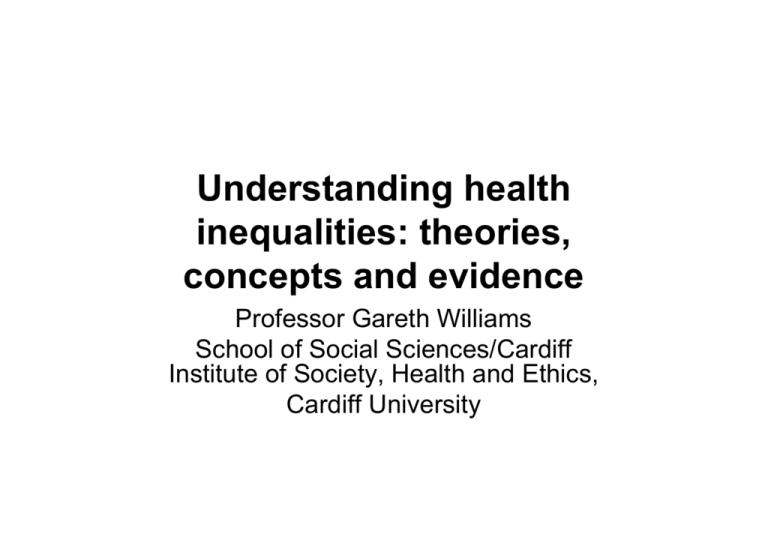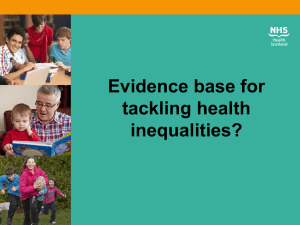
Understanding health
inequalities: theories,
concepts and evidence
Professor Gareth Williams
School of Social Sciences/Cardiff
Institute of Society, Health and Ethics,
Cardiff University
Mackenbach J.P. (2005). Health inequalities: Europe in Profile.
Independent, expert report commissioned by UK Presidency
of the EU.
•
•
•
•
•
•
Rates of mortality are consistently higher among those with a
lower, than among those with a higher socio-economic
position.
Inequalities in mortality start early in life and persist into old
age.
Inequalities in health are found for most but not all specific
causes of death.
Inequalities in health affect men and women but tend to be
larger among men.
Rates of morbidity are usually higher among those with a
lower educational, occupational or income level.
People with lower socio-economic positions live shorter lives
and spend a larger number of years in ill-health.
Conditions of the working class
‘That a class which lives under the conditions already sketched and
is so ill-provided with the most necessary means of subsistence
cannot be healthy, and can reach no advanced age, is selfevident…They are given damp dwellings… They are supplied bad,
tattered, or rotten clothing, adulterated and indigestible food. They
are exposed to the most exciting changes of mental condition, the
most violent vibrations between hope and fear…They are deprived
of all enjoyments except that of sexual indulgence and drunkenness,
are worked every day to the point of complete exhaustion of their
mental and physical energies, and are thus constantly spurred on to
the maddest excess in the only two enjoyments at their command…
How is it possible, under such conditions, for the lower class to be
healthy and long lived? What else can be expected than an
excessive mortality, an unbroken series of epidemics, a progressive
deterioration in the physique of the working population?’ (Friedrich
Engels 1982 [1892], The Conditions of the Working Class in
England in 1844, London: Panther).
Poor health in the working class,
1844: correlates and causes
•
•
•
•
•
•
Low incomes (‘ill-provided’)
Sub-standard housing (‘damp dwellings’)
Inadequate clothing (‘tattered or rotten’)
Poor diet (‘adulterated and indigestible’)
Psycho-social stress (‘violent vibrations’)
Bad occupational conditions (‘worked to
complete exhaustion’)
• Unhealthy behaviours (‘sexual indulgence and
drunkenness’)
• Power and control
Inequality and social
stratification
Three main dimensions:
• Social class (economy, money, material
resources)
• Social status or ‘honour’ (esteem,
reputation, respect)
• Political power (control, authority,
autonomy)
Explaining health inequalities
•
•
•
•
Inequalities in Health: Report of a Working
Group [The Black Report, 1980]:
Artefact
Social selection
Culture/behaviour
Material/structural conditions
Primacy given to material/structural
conditions, later supported in The Health
Divide (1987)
DIRECT SELECTION
HEALTH
HEALTH
SOCIAL
POSITION
INDIRECT SELECTION
BEHAVIOURS
HEALTH
Personal
characteristics
…x, y, z
SOCIAL
POSITION
Indirect selection
• Factors in early life (genetics, germs, ante/postnatal care) set the foundations
• These then are the ‘causes’ of social position
• They also influence health related behaviours
• Health behaviours ‘determine’ health
• No direct causal link between adult social
position and adult health
(Adapted from Mel Bartley, 2005)
Cultural/behavioural
• Forms of culture influence ‘salutogenic’
and unhealthy behaviours
• Use of unhealthy behaviours as a
diversion from daily difficulties (food, drink,
drugs)
• Interpersonal behaviours: crime, violence,
homicide, suicide/self-harm
• Long-term sick role behaviour as an
escape from pressures of everyday life
Materialist/Structural
• Material conditions have a direct impact on
health inequalities
• Absolute and relative poverty and deprivation
• Distribution of income and wealth
• Educational provision and opportunity
• Specific factors related to socio-economic
position: poor or crowded housing; insecure
employment; manual occupations; inadequate
diet
Recent developments in
explanation
• Psycho-social (effects of stressful conditions;
status differences; control and autonomy at
work; neighbourhood ‘cohesion’)
• Life-course (pre-natal events and processes or
in childhood ‘accumulate’ ‘risk’ and ‘resilience’ to
influence health in adulthood)
• Political economy (political processes and
distribution of power affect access to services,
assets and resources; neighbourhood ‘social
capital’)
Mental health, social cohesion and
neighbourhood low income
Why might income inequality
damage health and well-being?
• ‘Income inequality’ may influence aspects
of social relationships: relative importance
of domination versus mutual support
• It might be acting as an indicator of other
social institutions such as welfare,
education, housing, transport.
Social inequalities, social
cohesion and health inequalities
• Inequalities create sense of unfairness and
breakdown in social cohesion – breakdown of
support for communal structures, loss of private
investment and commitment
• Individual perceptions of inequality lead to
feelings of shame, envy, worthlessness, stress,
loss of mutuality and reciprocity, loss of respect
• Combinations of circumstances and perceptions
lead to: debt, overwork, ‘unhealthy’ coping
behaviours (‘demoralisation’)
How does it feel?
Five examples from empirical
research
A sense of unfairness
‘Look around and see the dirt and filth we
are now living in… We have poor housing,
high unemployment, all the shops are
closing down. People now have to travel
further for their needs. It’s a very poor
area in which to live’
(Elderly woman, Salford, England)
Feelings of stress
‘I think the biggest health risk is mentally…
‘cause it’s a lot of pressure and there’s nothing
really for you to do… you’re sort of segregated
all the time’.
(White, middle-aged man, Salford, England)
Feelings of worthlessness
‘The doctor put me on Prozac a few months ago,
for living here, because it’s depressing. You get
up, you look around, and all you see is junkies. I
know one day I’ll come off, I will get off here. I
mean I started drinking a hell of a lot more since
I’ve been on here. I have a drink every night just
to get to sleep. I smoke more as well. There’s a
lot of things…’
(Young single mother, Lancaster, England)
Economy, environment and
behaviour
‘Smoking and drinking and drug taking.
I put it down to one thing… until money is
spent on these areas… there doesn’t seem
to be much point in trying to stop people
smoking and what else. As long as the
environment is going down the pan the
people will go down with it’
(Middle-aged woman, Salford, England)
Going down the pan
In the space of six months about two years
ago I buried five drug-related [deaths]. The
youngest was 18 [years of age] and the oldest
was a 27 year old mother who lived in one of
the streets up here. And I knew her parents
fairly well, and she left a three-year old boy for
her parents to look after’
(Church Minister, Blaenau Gwent, south Wales)
Economy, society and history
[In South Wales] This was not just a case of localised
economic decline but rather one of cultural crisis. The
collapse of coalmining undermined a range of
mechanisms of social regulation that were grounded in
the politics of the workplace and the trades unions, but
spread more widely into local society and politics.
There was an acute sense of loss in places in which
coalmines closed after decades of existence’
(Katy Bennett et al Coalfields Regeneration: Dealing
with the Consequences of Industrial Decline, 2000)
Acheson (1997): beyond Black’s
four explanations?
Interpreting the boxes and
arrows
‘The important effects of not having
adequate power and resources to control
one’s circumstances, being made to feel
inferior, depression, hostility and lack of
support from a friendly social network are
central… to understanding why the quality
of social life in modern societies has not
kept pace with improvements in material
life’ (Richard Wilkinson, The Impact of
Inequality, 2005)
Life-course, environment,
resilience and capability
• Health inequality is the result of processes that
operate over the life course
• Social environments are potential sources of
capability and resilience
• Social environment influences individual
development and resilience through
relationships over time
• Social and economic policies influence
adequacy of individual resources for health and
quality of life = ‘capability’
Policy Levels for Tackling
Inequalities in Health









